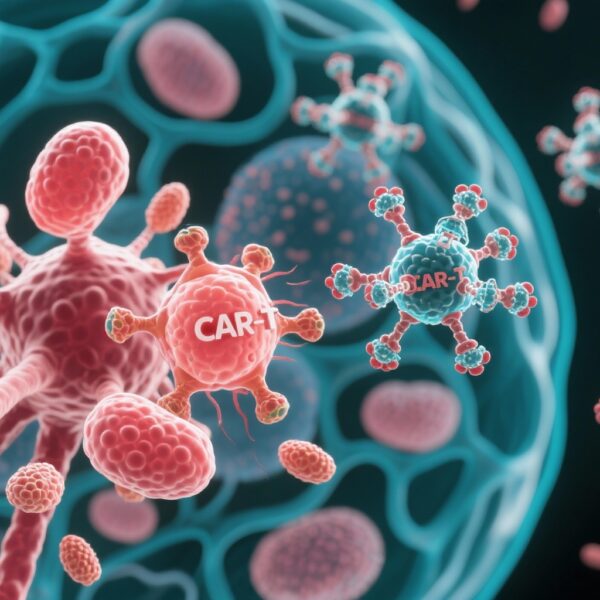Introduction
Waldenström macroglobulinemia (WM) is a rare indolent B-cell lymphoma characterized by lymphoplasmacytic infiltration and immunoglobulin M (IgM) monoclonal gammopathy. The advent of Bruton tyrosine kinase (BTK) inhibitors, particularly ibrutinib, has revolutionized WM treatment, gaining FDA approval following pivotal phase 2 trials demonstrating high efficacy and safety. However, the frequent somatic mutations in CXCR4—present in approximately 30-40% of WM patients—have been implicated in poorer responses to BTK inhibitors, reflected in lower rates of very good partial response (VGPR) and inferior progression-free survival (PFS). The addition of rituximab, an anti-CD20 monoclonal antibody, to ibrutinib (I+R) has shown promise in the randomized INNOVATE study, leading to FDA approval for combination therapy. Nevertheless, direct prospective comparisons between ibrutinib monotherapy and ibrutinib plus rituximab remain absent, particularly regarding the influence of CXCR4 mutational status. This gap necessitates pooled analyses to inform clinical decision-making and optimize personalized WM therapy.
Study Design and Methods
This pooled analysis incorporated patient-level data from three prospective clinical trials (NCT01614821, NCT02604511, NCT02165397), investigating ibrutinib monotherapy and ibrutinib combined with rituximab across treatment-naïve and relapsed/refractory WM populations. Patients lacking MYD88 mutations and those treated solely with rituximab were excluded to maintain a homogeneous cohort relevant to BTK inhibitor therapy. Demographic, baseline laboratory, mutation status (particularly CXCR4), treatment history, response metrics, and survival outcomes were harmonized. VGPR and other response categories were defined per the modified 6th International Workshop criteria. The primary endpoints included VGPR rate, 48-month PFS, and overall survival (OS). Statistical analyses employed multivariate logistic regression and Cox proportional hazards models, adjusting for pertinent prognostic factors such as IPSSWM and CXCR4 status, using appropriate corrections for multiple subgroup comparisons.
Key Findings
Among 174 evaluable patients (58 received I+R, 116 received I alone), VGPR rates did not differ significantly overall (38% I+R vs 28% I; P=0.21).
Patients’ baseline characteristics according to treatment group
| Variable | Ibrutinib monotherapy (n = 116) | Ibrutinib + rituximab (n = 58) | P value |
|---|---|---|---|
| Median age (range), y | 66 (56-71) | 66 (55-77) | .74 |
| Age >65 y, n (%) | 61 (53) | 36 (62) | .24 |
| Male sex, n (%) | 87 (75) | 34 (59) | .03 |
| Median hemoglobin (range), g/L | 105 (96-119) | 103 (92-116) | .50 |
| Hemoglobin <115 g/L, n (%) | 81 (70) | 41 (73) | .71 |
| Median platelet count (range), 103/μL | 215 (150-282) | 242 (166-340) | .15 |
| Platelet count <100 103/μL, n (%) | 11 (10) | 4 (8) | .67 |
| Median beta-2-microglobulin (range), mg/L | 5.2 (3.3-7.5) | 3.8 (3.0-5.0) | .001 |
| Beta-2-microglobulin >3.5 mg/L, n (%) | 96 (83) | 43 (74) | .18 |
| Median serum IgM (range), g/L | 38.4 (27.4-55.6) | 35.8 (18.2-51.4) | .17 |
| Serum IgM >70 g/L, n (%) | 8 (7) | 0 (0) | .04 |
| Previously treated, n (%) | 84 (72) | 27 (47) | .001 |
| CXCR4 mutations, n (%) | 44 (38) | 26 (45) | .38 |
| Low IPSSWM, n (%) | 21 (18) | 7 (13) | .67 |
| Intermediate IPSSWM, n (%) | 48 (42) | 25 (46) | |
| High IPSSWM, n (%) | 46 (40) | 22 (41) |
Patients’ baseline characteristics according to CXCR4 mutational status
| Variable | CXCR4 WT (n = 104) | CXCR4 MUT (n = 70) | P value |
|---|---|---|---|
| Median age (range), y | 66 (55-71) | 66 (56-71) | .48 |
| Age >65 y, n (%) | 56 (54) | 41 (59) | .54 |
| Male sex, n (%) | 75 (72) | 46 (66) | .37 |
| Median hemoglobin (range), g/L | 102 (94-116) | 108 (99-120) | .10 |
| Hemoglobin <115 g/L, n (%) | 76 (73.8) | 46 (67.6) | .38 |
| Median platelet count (range), 103/μL | 252 (174-329) | 184 (121-247) | .001 |
| Platelet count <100 103/μL, n (%) | 4 (4) | 11 (17) | .004 |
| Median beta-2-microglobulin (range), mg/L | 5.0 (3.3-7.2) | 4.0 (3.0-7.0) | .082 |
| Beta-2-microglobulin >3.5 mg/L, n (%) | 88 (85) | 51 (73) | .058 |
| Median serum IgM (range), g/L | 33.6 (20.8-51.3) | 43.1 (32.5-58.7) | .011 |
| Serum IgM >70 g/L, n (%) | 5 (5) | 3 (4) | .87 |
| Previously treated, n (%) | 70 (67) | 41 (59) | .24 |
| Ibrutinib + rituximab, n (%) | 32 (31) | 26 (37) | .38 |
| Low IPSSWM, n (%) | 19 (18) | 9 (14) | .63 |
| Intermediate IPSSWM, n (%) | 42 (41) | 31 (47) | |
| High IPSSWM, n (%) | 42 (41) | 26 (39) |
However, patients harboring CXCR4 mutations exhibited distinct therapeutic responses. In this subgroup, I+R tended toward higher VGPR rates (27% vs 11%; P=0.10) and demonstrated a statistically significant improvement in 48-month PFS (72% vs 43%; P=0.03) compared to ibrutinib monotherapy. CXCR4 mutations conferred poorer outcomes on ibrutinib alone, with significantly inferior VGPR (17% vs 42%) and PFS (43% vs 72%). Notably, in the I+R arm, while VGPR rates remained numerically lower in CXCR4-mutated versus wild-type patients, PFS was comparable (74% vs 72%). Multivariate analyses confirmed CXCR4 mutational status as an independent predictor of impaired VGPR and PFS with monotherapy but not with combined treatment.
Other subgroup analyses revealed no robust benefit of adding rituximab among patients with wild-type CXCR4, nor significant differences based on treatment-naïve status or IPSSWM risk categories. OS rates were high and similar between treatments across subgroups, underscoring the indolent nature of WM and the effectiveness of current therapies.
Expert Commentary
These findings elucidate the nuanced role of rituximab addition within BTK inhibitor regimens conditional on CXCR4 mutational status. CXCR4 mutations mechanistically engender BTK inhibitor resistance via downstream Akt and ERK activation pathways, mitigating ibrutinib efficacy. The significant PFS improvement with I+R in CXCR4-mutated patients suggests rituximab contributes synergistic activity, potentially through mechanisms such as antibody-dependent cellular cytotoxicity and complement activation, possibly overcoming or delaying resistance.
The lack of clear additive benefit in CXCR4 wild-type patients aligns with previous data and suggests that ibrutinib monotherapy remains a viable standard in this subgroup, reserving the combination approach for molecularly defined higher-risk patients. The complexity of rituximab administration, including infusion reactions and logistical considerations, further supports personalized treatment strategies guided by CXCR4 status.
Comparative efficacy data with newer BTK inhibitors like zanubrutinib, which show some improved tolerability and efficacy, particularly in CXCR4-mutated WM, remain preliminary. The potential for combinations of next-generation BTK inhibitors with rituximab warrants further investigation. Additionally, alternative regimens such as bendamustine plus rituximab or proteasome inhibitors offer CXCR4-independent efficacy but bear distinct toxicity profiles.
Limitations of this pooled analysis include its retrospective nature, heterogeneity of patient populations, treatment settings, and follow-up durations, as well as potential selection biases. Variations in CXCR4 mutation detection methods and inability to adjust for some confounders should temper overinterpretation. Nonetheless, these data provide valuable insights in the absence of prospective head-to-head trials.
Conclusion
In summary, the pooled analysis reinforces that addition of rituximab to ibrutinib significantly prolongs progression-free survival in patients with Waldenström macroglobulinemia harboring CXCR4 mutations, with a trend toward deeper responses. Routine CXCR4 mutation testing emerges as a critical component in therapeutic planning to identify patients most likely to benefit from combination therapy. These findings advocate for continued development and clinical trials incorporating rituximab with both covalent and noncovalent BTK inhibitors to optimize outcomes in WM.
References
Guijosa A, Ramirez-Gamero A, Sarosiek S, Branagan AR, von Keudell G, Treon SP, Castillo JJ. Ibrutinib plus rituximab vs ibrutinib monotherapy in patients with Waldenström macroglobulinemia: a pooled analysis. Blood Adv. 2025 Sep 23;9(18):4705-4715. doi: 10.1182/bloodadvances.2025016536 IF: 7.1 Q1 . PMID: 40674744 IF: 7.1 Q1 .



![Categorical response analyses. Categorical responses to ibrutinib plus rituximab (I+R) and ibrutinib monotherapy (I) in the entire cohort (I, 118; I+R, 58) (A); patients with CXCR4 mutations (I, 44; I+R, 26), showing numerical improvements in VGPR (B); and patients with high IPSSWM scores (I, 46; I+R, 22) (C). Categorical responses according to CXCR4 mutational status in the entire cohort (WT, 104; mutated [MUT], 70) (D); in patients treated with I+R (WT, 32; MUT, 26) (E); and in patients treated with I alone (WT, 72; MUT, 44) (F). mR, minor response; NR, no response; PR, partial response.](https://ash.silverchair-cdn.com/ash/content_public/journal/bloodadvances/9/18/10.1182_bloodadvances.2025016536/1/m_blooda_adv-2025-016536-gr2.jpeg?Expires=1761362151&Signature=ZQ0n~1-2veTrp2e9jUKUHNdkWeAkNIxN84K6yHg1LS70tUmQH~ypfA0BXs90kGTpOnhDx0mgYnvX02FIMavQN4IkXEsjqb6x4GBboFvFWMf4qTW4p5N7YOOb3kfstSBXLD4WCB2t1aH94mtUdjwDf6-wQXy5OlpQpaei6LedP4IQhb~DtXCXDp~wsB5LVFzp23xIMSIfwAQJ83eCmLeM6g7AgO8cqGoN2FVqQChrhkha7NMmxBPBbqAKCUCaOJSqQwd0XbjWg7U1~Oivccd9e9UTPxcw4g~yyDppwSFF~Jxqtu43kMlej394JUDaXn0H~6M4Ls5o80YFAoHIGRct6Q__&Key-Pair-Id=APKAIE5G5CRDK6RD3PGA)

